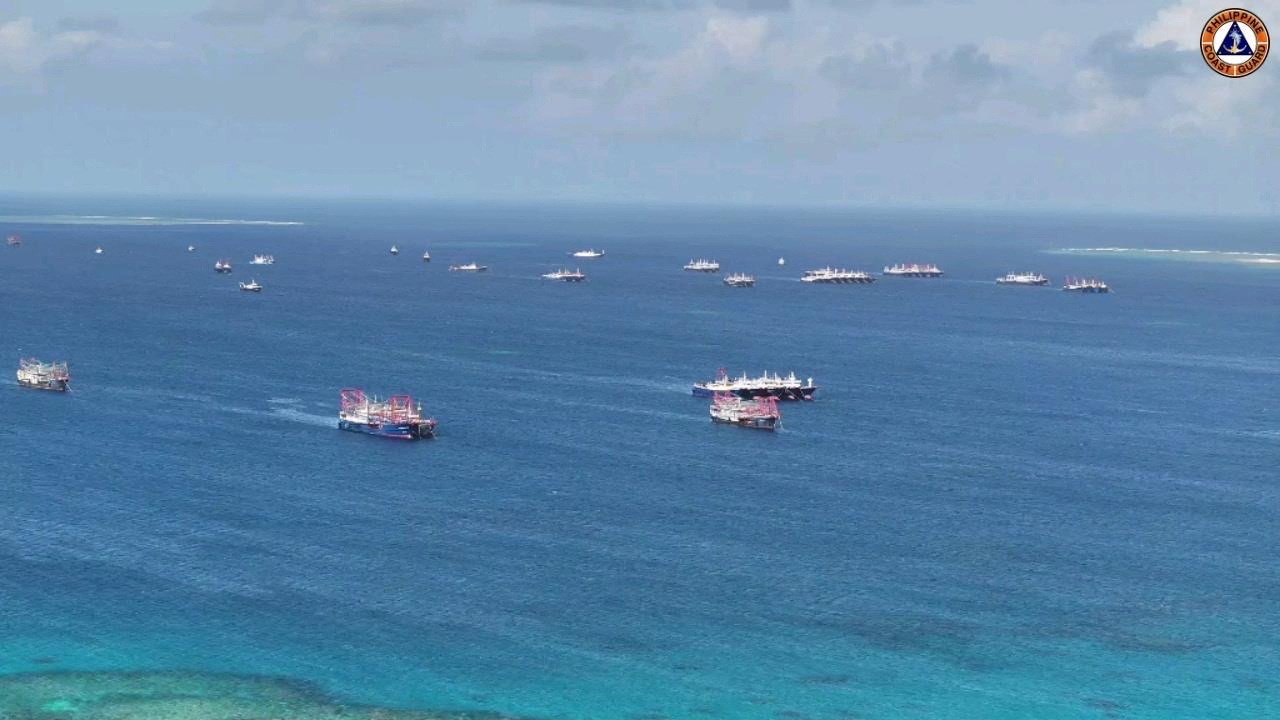US think tank: 195 Chinese vessels linger daily in South China Sea

FILE PHOTO: Chinese militia vessels operate at Whitsun Reef in the South China Sea, December 2, 2023. Philippine Coast Guard/Handout via REUTERS/File Photo
About 195 Chinese militia ships were present on any given day last year around key features in the South China Sea, according to a Washington-based think tank.
This is a “35-percent increase” compared with the 12-month period of 2021-2022, the Asia Maritime Transparency Initiative (Amti) said in a Feb. 28 report, citing satellite imagery last year of 10 features across the South China Sea “known to be frequented by Chinese militia ships.”
The images showed 180 militia ships in Panganiban (Mischief) Reef from June to August, compared with 37 vessels in 2022.
Amti described this increase as an “anomaly.” According to its report, the deployment of more vessels was also marked by “a dramatic shift” in their presence toward Panganiban Reef.
Panganiban Reef, which is about 232 kilometers from Palawan province, is part of the Philippines’ exclusive economic zone (EEZ). The think tank noted that China “first took possession of that feature in 1994.”
But it remained “unclear” why China sent more militia vessels, Amti said. Still, it noted that China’s militia remained as “active as ever,” especially considering their role as “a force … ostensibly engaged in commercial fishing but in fact operat[ing] alongside Chinese law enforcement and military.”
‘Largest artificial island’
Maritime law expert Jay Batongbacal told the Inquirer in an earlier interview that “Most likely the militia fleet is being sent [to areas where] it is best positioned to operate closer to the Philippines, and also because of availability of supplies and facilities for the vessels and crew.”
He pointed out that Panganiban Reef, under China’s occupation, has become “the largest artificial island” in the South China Sea.
The reef has port facilities that service the People’s Liberation Army-Navy, the China Coast Guard (CCG) and militia ships, said Batongbacal, head of the Institute for Maritime Affairs and the Law of the Sea of the University of the Philippines.
READ: WPS economic sanctions to hurt PH, but China even more
He said Panganiban Reef also has antiair and antiship missiles, radars and jammers. It is used as a base by Chinese surveillance aircraft and “could also be used as an air base by combat aircraft,” he added.
Apart from Panganiban, “the largest consistent groupings of militia ships continued to be seen at McKennan (Hughes) Reef and Julian Felipe (Whitsun) Reef,” Amti said of the two features still within the West Philippine Sea.
It added that a “persistent militia presence” is also maintained near Gaven Reef, just outside the Philippines’ EEZ, and at reefs east of Philippine-occupied Pag-asa Island.
In January, Commodore Roy Vincent Trinidad, the Philippine Navy spokesperson for the West Philippine Sea, said about 200 Chinese militia vessels, including 10 to 15 CCG ships, were spotted in the West Philippine Sea at any given day.
Col. Francel Margareth Padilla, Armed Forces of the Philippines spokesperson, told the Inquirer last week that the military plans to conduct more Maritime Cooperative Activities (MCAs), as the AFP calls its joint patrols and exercises with the United States and other allies.
“The AFP is eager to conduct more MCAs in the future, with the goal of making it a routine and periodic exercise to enhance our interoperability not only with the US Armed Forces but with other like-minded countries as well,” she said.
For comprehensive coverage, in-depth analysis, visit our special page for West Philippine Sea updates. Stay informed with articles, videos, and expert opinions.